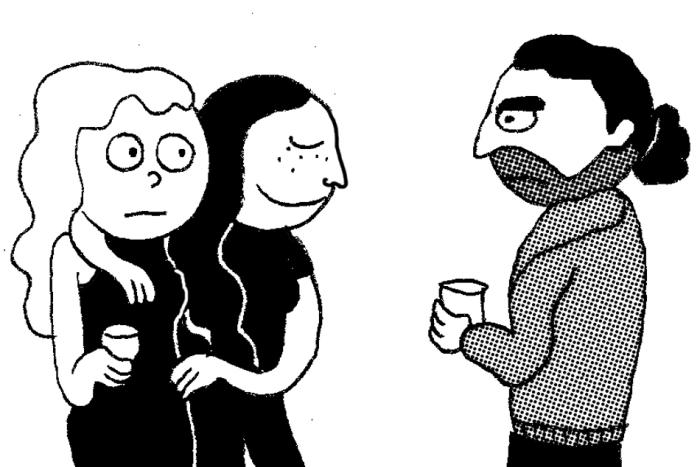On May 15, 1932, a cabal of 11 youthfully reactionary naval officers stormed Japanese Prime Minister Inukai Tsuyoshi’s residence. “If I could speak, you would understand,” he told them, to which the conspirators replied, with fascist brevity, “Dialogue is useless,” and then bullets. The historical consequences of that assassination—Tsuyoshi would be the last head of government meaningfully independent from Japan’s generals (or occupiers) until decades later—don’t fascinate me as much, however, as the murderers’ initial decision to target the visiting Charlie Chaplin, too. Displaying an almost touching faith in the political power of mass culture, they believed that killing a clown could start a war. And despite going about it in the typical militarist’s press-X-launch-Y manner, they weren’t entirely delusional.
In Japan, as in every other global power, modernism spread through cinema, radio, and pulp. One distinctly local manifestation was the mass-culture phenomenon of ero guro or “erotic grotesque nonsense,” works fascinated by the sexual, the aberrant, the misshapen and the absurd—sometimes all at once. As the scholar Jim Reichert has noted, erotic-grotesque stories or art tended to depict “deviance” in a manner “simultaneously celebratory and alarmist,” mutilating cultural norms yet pathologizing such challenges to fascistic homogeneity through the still-new disciplines of sexology, psychology and criminology. The writer Edogawa Rampo wrung this tension to great commercial effect, churning out macabre adventures and horror-tinged mysteries. His novella The Strange Tale of Panorama Island was just published in English for the first time, twice over, but the prose translation by Elaine Kazu Gerbert perversely tantalized me less than Suehiro Maruo’s lush manga adaptation.
When I described contemporary ero guro comics as “extravagantly cruel theatre” several months ago, I was thinking of Maruo. Approaching 60 now, most of his work remains unpublished in North America, partly because what has been published features titles such as Ultra Gash Inferno. It ranges from the dark shojo parody of Mr. Arashi’s Amazing Freak Show to vignettes influenced by the Muzan-e woodcuts and their artful gore, where pretty youths undergo extreme torture and debasement. Maruo’s women and men are beautiful, delicate and exquisitely drawn, even when gasping out sticky, tarry blood. On a recent podcast, tongue hanging only halfway through his cheek, comics critic Joe McCulloch described the artist’s typical protagonists as “freaks who see that life is garbage and you have to live like animals,” arguing that, for their creator, these “highly amoral or immoral characters nonetheless embody the poisonous spirit of Japan in the run-up to militarism.” Maruo is a nostalgist drawn to the past by fascinated disgust. Some of his briefer work seems so ardently aestheticized that it reads as less an indictment of misogynistic imagery than recapitulation.
My favourite Maruo story maintains such ambivalence only long enough to fulfill its annihilation. “Planet of the Jap” imagines the Imperial Army winning World War II and embarking on a genocidal rampage, slaughtering families, desecrating the Statue of Liberty, ritualistically decapitating Douglas MacArthur. The invading troops move in stylized black uniforms like sharp obsidian. They’re even inspired to borrow American atrocities: As Los Angeles vanishes beneath a nuclear bomb, as the gaijin shogun’s severed head rolls off the page to his executioner’s orgasmic delight, what came on like adolescent fantasy curdles into aridly deadpan satire and moral estrangement. It’s as if one were watching a nationalist-martyrdom parable and the grand stage collapsed to reveal a sad little reactionary, masturbating.
Panorama Island’s transgressions are more genteel. Edogawa Rampo made his pen name a play on the Japanese pronunciation of “Edgar Allen Poe,” and the violence in his stories tends to be similarly implicit, latterly exhumed. The text even cites a pertinent Poe story by name, although this adaptation’s atmosphere of sinister leisure has more in common with Last Year at Marienbad or Patricia Highsmith’s Ripley novels. When the weedy, struggling writer Hirosuke learns an old classmate and lookalike has died, he decides to steal the man’s identity, his wife Chiyoko, and his vast family fortune. (Discovering a false tooth while digging up the corpse, he pulls his own out in a frenzy so that the reflection is accurately marred.) Hirosuke uses the corporate wealth to recreate the setting of an unsold book, a decadent, languorous island, his own personal “pleasure kingdom.” “We’ll provide an escape from the economic malaise,” he promises; Panorama Island was first published in 1926, a year before the Taisho period gave way to financial crisis.
Decompressed even by serial manga standards, Maruo’s version of the Rampo novella lolls across nearly 300 pages, few of them troubled by much plot. He lavishes dozens and dozens on the triumphant tour Hirosuke gives to Chiyoko: Underwater tunnels curving through aquatic exotica, architectural pastiches, humans in form-fitting animal guise, frolicking hedonists, wanton industrial abstractions with no purpose, “dream machines that produce nothing.” Optical illusions make a staircase appear to tower into the sky and ornate gardens stretch beyond the horizon; the island itself contains one, having been carved into a floral shape that only Hirosuke can discern. His solipsism is total.
French intellectual Georges Bataille, who shared Maruo’s ocular fixation—one astonishing panel here shows a peacock shaking its plumage into a collage of gaping eyes—once declared that, “if literature stays away from evil, it rapidly becomes boring.” In its unhurried perversity, Panorama Island suggests that amorality will do the trick as well. When the paranoid Hirosuke finally murders his bride, Maruo is rather uncharacteristically restrained, omitting his source material’s necrophilic tone (“Chiyoko’s pale fingers began to describe the beautiful curves of death agony”) and hints of male impotence. He renders the act as yet another aesthetic whim. It’s not that Chiyoko figured out her purported husband’s deception—it’s how she wants him anyway, and allowing that would ruin his design.
Panoramas were a documented cultural phenomenon, sating audiences until the maturation of cinema. In the introduction to her new translation of the novella, Elaine Kazu Gerbert describes an early spectacle from 1890: “37 metres in diameter and 16 metres tall, with a ridgepole 29 metres high, it featured ‘phantom-like scenes from the Battle of Gettysburg to the accompaniment of a music box’ and was open all day long continuously throughout the year.” Many panoramas featured combat landscapes. Both Rampo and Maruo include amongst Hirosuke’s simulations the rolling fields of Manchuria—ones that would soon be visited by Japanese tanks instead. Did any occupiers recognize the terrain, inadvertently trained in war by some childhood amusement?
Just as Hirosuke is holding forth in his sauna, lamenting to naked followers that he can’t summon Nijinsky to dance for them, a Detective Akechi arrives from Tokyo. It turns out that decadent novel got picked up after all, inconveniently publishing the details of the impostor’s entire scheme. (“As it’s [fiction], murder can be committed freely,” the investigator drolly notes in parenthesis.) Hirosuke makes no effort to escape, only asking for half an hour to settle his affairs: “Now the price must be paid for this extreme lavishness.” Minutes pass. Orgies resume. Another round of fireworks goes off. And rain follows it, staining instead of cleansing, spattering reddish ichor. A stunned Akechi notices the fugitive’s hand lying before him, fingers curled like dismembered petals. In his opening pages, Maruo gives that sparkler-blast the contours of an atomic bulb. As I write now, it’s been exactly 68 years since the bombing of Hiroshima, against which dialogue proved no more useful than cultish fascism or anti-aircraft defenses. Along with that day, we should remember this: The American government didn’t much care for certain jesters in its court, either. I always thought nuclear war seemed most horrific in comic books.





